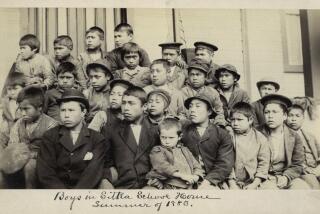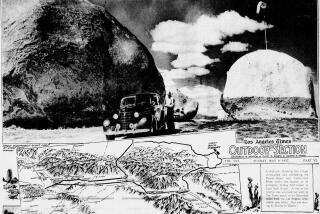Discoveries
Battle Rock: The Struggle Over a One-Room School in Americaâs Vanishing West, William Celis, Public Affairs: 221 pp., $25
This story about a one-room schoolhouse in a Colorado canyon began as an article in the New York Times. The Battle Rock School was founded in 1915 and for almost 80 years most of the students were cousins, brothers and sisters. In the 1990s, this changed dramatically (according to Celis, 5.2 million Americans in urban areas moved to the country). There was also an increase in the number of one-room schoolhouses, but the mix of relatively wealthy urban kids and locals proved toxic, at least in McElmo Canyon at Battle Rock School.
For the record:
12:00 a.m. Oct. 30, 2002 For The Record
Los Angeles Times Wednesday October 30, 2002 Home Edition Main News Part A Page 2 ..CF: Y 11 inches; 420 words Type of Material: Correction
Authorâs name -- The first name of the author of âZipping My Flyâ was incorrect in Book Review on Sunday. The authorâs name is Rich Tosches.
For The Record
Los Angeles Times Sunday November 03, 2002 Home Edition Book Review Part R Page 14 Features Desk 2 inches; 92 words Type of Material: Correction
Authorâs name--The first name of the author of âZipping My Flyâ was incorrect in Book Review on Oct. 27. The authorâs name is Rich Tosches.
Parents fought over everything from indoor (modernized) toilets versus outhouses (the way it had always been) to a picture in a reference book of Botticelliâs Venus, which caused many of the locals to take their kids out of the school. Celis spent a school year living in nearby Cortez and attending the school, where the students, grades one through six, were taught by 40-year-old Stephen Hanson. In the end, a reader sees the arguments over education in the 20-student school from both sides, but, ultimately, his sympathies lie with the locals.
Zipping My Fly: Moments in the Life, of an American Sportsman, Rick Tosches, Perigree/Penguin: 245 pp., $19.95
A $6,875 trip to New Zealand to write a 10,500-word article on fly-fishing, Rick Tosches explains, had âa lot to do with why I donât work for the Los Angeles Times anymore.â Tosches is a weeper; his humor is an explosive mix of Dave Sedaris and Dave Barry, as he tries, in several essays, to do justice to the absurdity of fly-fishing, (the sport, Tosches reminds us, that is often referred to as âa jerk on one end of a line waiting for a jerk on the other), from Alaska to New Zealand to the World Fly-Fishing Championship in Jackson Hole, Wyo. Turns out he wasnât too upset about leaving L.A. for Colorado. Not enough water in a city where everything is paved, with the exception of âthe ocean, which the City of Los Angeles could not pave because, as I understand it, Johnny Carson owns it.â And so it goes. Even the chapter titles poke fun at the sanctimonious eggheads of this world: âThe Drivel Runs Through It,â âDances With Morons.â Thereâs a fair share of little boy humor as well, on the favored subjects of nose-blowing, farting and drinking, but even these can get you going. Fishing with a hangover, Toschesâ friend keeps shouting at the flies, âJesus Christ, do they have to beat their wings on the water like that?â
Letters on Cezanne: Rainer Maria Rilke, Translated from the German by Joel Agee, Edited by Clara Rilke, North Point Press: 84 pp., $13
Joel Agee, translator of this volume of little-known essays on the many ways that Cezanneâs paintings inspired the poet, admits in his foreword that there are places in these essays where Rainer Maria Rilkeâs âlove of precision seems to have abandoned him.â There are places in âLetters on Cezanneâ where Rilke struggles to absorb âthat balance between the reality of nature and the reality of the image which was Cezanneâs entire striving.â
In the fall of 1907, a year after the painter died, Rilke went every day to the Salon dâAutomne to sit in a room filled with Cezannes. âYou can feel,â he wrote, âwhat a light green carriage can be on the Pont-Neuf or some red that canât contain itself, or simply a poster on the fire wall of a pearl-grey group of houses.â He admires Cezanneâs âplainspoken truth,â his deference to the power of color. Cezanne could make âsaintsâ out of an apple or a bottle of wine âand forces-forces them to be beautiful.â
The writing is clearly inspired, almost breathless: âAvenues,â he wrote stepping out into the streets of Paris, âflowing toward you in a scarcely perceptible downward slope, fast and rich and like a river.... And all of this lies out there with the generosity of a born landscape, and casts forth space.â
More to Read
Sign up for Essential California
The most important California stories and recommendations in your inbox every morning.
You may occasionally receive promotional content from the Los Angeles Times.










